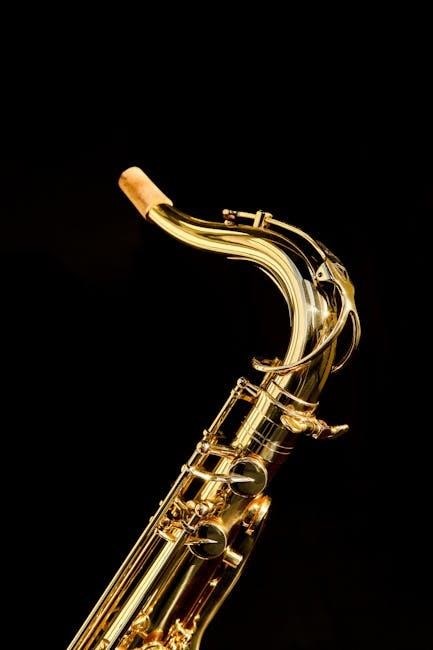The saxophone mouthpiece acts as a bridge between the player and the instrument, directly influencing sound quality and playability. It consists of key components like the tip opening, chamber, and material, each contributing to the overall tone and response. Proper selection and maintenance are crucial for optimal performance, making it a vital part of every saxophonist’s setup.
1.1 The Importance of the Mouthpiece
The sax mouthpiece is pivotal in shaping tone, playability, and overall performance. It directly impacts the player’s ability to produce the desired sound, making it a critical component. A well-suited mouthpiece enhances comfort, intonation, and response, while a poor fit can hinder technical execution and tone quality. Many saxophonists spend considerable time finding the ideal mouthpiece, as it personalizes their sound and playing experience. Its importance cannot be overstated, as it bridges the player’s technique with the instrument’s acoustic properties, making it essential for achieving musical goals.
1.2 Key Components of a Sax Mouthpiece
A sax mouthpiece comprises several critical parts, each affecting performance. The tip opening determines air flow and reed vibration, influencing brightness and responsiveness. The chamber shapes the tone, with sizes varying to suit different styles. The material, often hard rubber or metal, impacts warmth and clarity. The baffle and facing lengths also play roles in tone and playability. Together, these components create a balance of sound and comfort, making each mouthpiece unique in its characteristics and suitability for various musical genres and player preferences.

Factors Influencing Mouthpiece Selection
Musical style, tip opening, chamber size, and material type are key factors. Playability and personal preference also matter, ensuring the mouthpiece suits the player’s sound and comfort needs.
2.1 Tip Opening and Its Impact on Sound
The tip opening, the distance between the reed and mouthpiece tip, significantly affects sound and playability. A larger opening produces a brighter, more projecting tone, often preferred in jazz, while a smaller opening yields a warmer, more mellow sound, commonly used in classical music. Properly matching the tip opening to the player’s embouchure and musical style ensures optimal performance and comfort. Testing different openings helps determine the best fit for individual needs and desired tonal characteristics.
2.2 Chamber Size and Its Role in Tone
The chamber size of a sax mouthpiece plays a crucial role in shaping the tone. A larger chamber tends to produce a darker, richer sound, often preferred by classical players, while a smaller chamber results in a brighter, more agile tone, commonly sought after in jazz. The chamber’s dimensions influence the harmonic complexity and overall resonance. Properly matching the chamber size to the player’s style and preferences ensures a balanced and desired tonal output, making it a key factor in mouthpiece selection.
2.3 Material Types: Hard Rubber vs. Metal
Sax mouthpieces are primarily made from hard rubber or metal, each offering distinct tonal characteristics. Hard rubber mouthpieces are known for their warmth, richness, and versatility, making them a popular choice for both jazz and classical players. Metal mouthpieces, while less common, deliver a bright, bold sound with excellent projection, often preferred by those seeking a modern, edgy tone. The material significantly impacts the sound quality and player comfort, making it a critical factor in mouthpiece selection based on individual preferences and musical style.

Choosing a Mouthpiece by Musical Style

The sax mouthpiece selection largely depends on the musical genre, as jazz and classical require different tonal preferences, guiding players to specific designs for optimal sound and playability.
3.1 Jazz vs. Classical: Different Mouthpiece Needs
Jazz and classical music demand distinct mouthpiece characteristics. Jazz players often prefer brighter tones with more projection, opting for larger tip openings and narrower chambers. In contrast, classical musicians favor a warmer, more mellow sound, achieved with smaller tip openings and larger chambers. These differences ensure the mouthpiece aligns with the stylistic requirements of each genre, enabling players to achieve the desired tonal quality and performance.
Popular Sax Mouthpiece Brands
Top brands include Yamaha, known for consistency and quality, Theo Wanne for innovation, and Rousseau for versatility, each catering to different player preferences and needs.
4.1 Yamaha Mouthpieces
Yamaha mouthpieces are renowned for their exceptional quality and consistency. They offer a wide range of models, such as the 4C and 5C, which are popular among saxophonists. These mouthpieces are designed to provide a balanced tone and excellent playability, making them suitable for both beginners and advanced players. Yamaha’s attention to detail ensures durability and optimal performance, solidifying their reputation as a trusted choice in the saxophone community. Their versatility across different musical genres further enhances their appeal to a broad spectrum of musicians.
4.2 Theo Wanne Mouthpieces
Theo Wanne mouthpieces are highly regarded for their exceptional craftsmanship and rich, resonant sound. Designed with precision, they cater to saxophonists seeking a warm, dynamic tone. Popular among jazz players, these mouthpieces offer a wide range of options to suit individual preferences. Theo Wanne’s innovative designs enhance resonance and projection, making them a favorite among professionals. Their commitment to quality ensures a superior playing experience, making Theo Wanne mouthpieces a top choice for saxophonists aiming to achieve a vibrant and expressive sound.
4.3 Rousseau Mouthpieces
Rousseau mouthpieces are a trusted choice among saxophonists, offering a legacy of quality and precision. Known for their balanced tone and versatility, they are favored by professionals and students alike. The Rousseau 5R model is particularly popular, delivering a smooth, full-bodied sound suitable for both jazz and classical styles. With a focus on craftsmanship, Rousseau mouthpieces provide consistent performance and a wide range of tonal possibilities, making them a preferred choice for saxophonists seeking clarity and expression in their music.

The Role of Reeds and Ligatures

Reeds and ligatures play a crucial role in shaping the saxophone’s sound. They influence tone, response, and overall playability, ensuring proper vibration and a secure fit for optimal performance.
5.1 Importance of Reed Selection
Reed selection is critical for achieving the desired tone, response, and playability. The strength and material of the reed significantly impact the sound produced, with softer reeds offering easier playability and harder reeds providing brighter tones. Proper reed choice aligns with the player’s embouchure, air support, and musical style. High-quality reeds ensure consistency and reliability, while poor-quality ones can hinder performance. Brands like Rico, Hemke, and Vandoren offer diverse options, catering to different preferences and skill levels. Testing reeds is essential to find the optimal match for individual needs and setups.
5.2 How Ligatures Affect Sound
Ligatures play a subtle but significant role in shaping the saxophone’s sound. They secure the reed to the mouthpiece, influencing vibration and tone. Tighter ligatures can produce a brighter, more focused sound, while looser ones may allow for greater warmth and flexibility. The material of the ligature—whether metal, fabric, or leather—also impacts the tone, with metal ligatures often enhancing clarity and fabric ones softening the sound. Proper ligature fit and adjustment are essential for optimal reed performance and consistent playability across the instrument’s range.

Testing Mouthpieces
Testing mouthpieces involves trying different models to find the best fit for your sound preferences. Play in a quiet room with your usual reed strength to evaluate tone, intonation, and response. Consider comfort and playability across the instrument’s range to ensure the mouthpiece meets your musical needs.
6.1 What to Look for in a Mouthpiece Trial
When testing a mouthpiece, focus on tone quality, intonation, and response across the saxophone’s range. Play in a quiet room to assess clarity and pitch accuracy. Consider comfort and ease of playability, especially in high and low registers. Use a metronome to evaluate articulation and consistency. Compare multiple models to find the best match for your sound preferences and musical style. Ensure the mouthpiece feels balanced with your reed and ligature setup for optimal performance.
Maintenance and Care
Regular cleaning prevents bacteria buildup. Use mild soap and warm water, then dry thoroughly. Store in a protective case to avoid scratches. Avoid extreme temperatures and handle gently to maintain longevity.
7.1 Cleaning and Hygiene Practices
Cleaning your sax mouthpiece is essential for maintaining hygiene and sound quality. Use a soft cloth to wipe the exterior daily. For the interior, a mouthpiece brush with mild soap and warm water is recommended. Avoid harsh chemicals that could damage the material. Regularly sanitize using a solution of equal parts water and white vinegar. After cleaning, dry thoroughly to prevent moisture buildup, which can lead to mold and bacteria growth. Consistent hygiene practices ensure optimal performance and longevity.
7.2 Storage Tips for Longevity
Proper storage is crucial for maintaining your sax mouthpiece’s condition. Store it in a protective case or soft pouch to prevent scratches and damage. Avoid extreme temperatures and direct sunlight, as they can warp the material. Keep the mouthpiece dry and free from moisture to prevent corrosion. For extended storage, place it in a cool, dry environment. Consider using silica gel packets to absorb humidity. Always store the mouthpiece separately from the saxophone to avoid accidental damage. Regularly inspect the case for wear and replace it if necessary to ensure optimal protection.



About the author